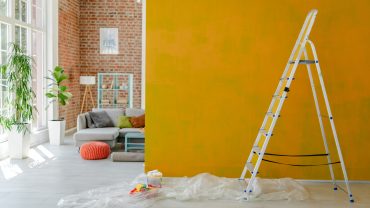Lose the Plastic Bags and Plastic Wrap

Fresh fruits or vegetables in a reusable shopping bag. (Credit: Aleksandr Zubkov via Getty images)
There are so many alternatives to wrapping your lunch and your leftovers in disposable products! You can get reusable bags for food made of canvas and silicone. You can get a reusable bag made of non-toxic plastic that zips up. Another option is adorable fabric wraps for food that stay put through the power of beeswax. Warm the fabric with your hands and the wax softens. Drape it over the bowl or wrap a bit of food in it, and the wax cools, creating a seal.
Use All-Natural Cleaning Products

Natural homemade cleaner supplies (Credit: wera Rodsawang via Getty Images)
Cleaning your house doesn’t have to mean dirtying the planet. Use products made from safe, non-toxic ingredients that don’t harm the environment. Conventional cleaners include harmful ingredients like formaldehyde, chloroform, and 1,4-dioxane that end up in the air and water. If you mix up your own cleaners, you also skip one-use, disposable packaging that’s used in many products.
Skip the Bottled Water

A heap of disposable water bottles next to a reusable water bottle (Credit: Richard Drury via Getty Images)
All the bottled water we chug in the name of clean water is strangling the planet with plastic. People, we don’t need it. Most city water supplies have safe, fresh water. If you don’t like tap water’s taste, get a home filtration system, even if it’s just a water-filtering pitcher you keep in the fridge. If you like the convenience of bottled water, get a refillable one and keep it with you at all times.
Use Glass Storage Containers for Food

Glass jars filled with healthy food (Credit: fcafotodigital via Getty Images)
It’s good you keep those leftovers instead of adding them to the 161 billion pounds of food Americans send to landfills. Store that food in glass containers instead of those plastic ones. You’re won’t be completely plastic-free, because most glass containers on the market have plastic lids, but you’ll use a lot less of it. If you want to be totally plastic-less, IKEA makes a line of glass containers with bamboo lids. Or look for vintage Depression-Era containers with glass lids (and fabulous Art Deco style.)
Skip Fast Fashion

Clothing on display racks (Credit: Helen King via Getty Images)
Fast fashion — the trendy, dirt-cheap duds that fill the racks at low-cost clothing chains — is good for your budget but bad for the planet. Instead of buying the latest style for a song and tossing it at the end of the season, invest in high-quality pieces in classic styles that will last for years. And shop at charity, consignment and vintage shops for used clothes.
Put Up a Clothesline

Washing hanging on a Washing Line (Credit: Catherine Falls Commercial via Getty Images)
Letting sunshine and breezes dry your clothes is peak green living. That fresh air makes your clothes smell great! And air-drying your clothes cuts your household’s carbon footprint by 10 percent.
Swap Out Your Old Light Bulbs With LEDs

Energy-Saving light bulb (Credit: boonchai wedmakawand via Getty Images)
LED bulbs use up to 80 percent less electricity than traditional bulbs. This means power plants that belch greenhouse gases don’t have to run as much to keep the lights on when they’ve got LED bulbs in them. Another benefit to LEDs: They last an average of 14 times longer, meaning fewer dead bulbs end up in landfills.
Buy a Razor That Will Last the Rest of Your Life

Eco razor (Credit: Olena Ruban via Getty Images)
Stop buying disposable razors and disposable razor cartridges. Buy a safety razor. That’s what you call a metal one that uses all-metal replacement blades. You’ll get a better shave and stop sending dead plastic razors to landfills. Safety razors are a lovely example of retro industrial design, so your shave will be like time-traveling to the 1930s. Women, you can use these, too.

Woman taking photo of denim shirt on smartphone
Resell and Donate Your Used Things
You may not want it, need it, or use it anymore, but someone else out there does. Find a new owner for your stuff by donating it to a thrift store, taking it to a consignment store, or listing it for sale or giveaway online, or any other social media that connects people who don’t want an item with people who do.
Go Retro With a Good Pen

Fountain pen (Credit: Creativeye99 via Getty Images)
Get a classy, refillable pen. They make whatever you write feel so significant, even if it’s just a grocery list. In earlier generations, a pen was a tool we kept for years, an attitude we should rediscover. Bic celebrated making its 100 billionth disposable pen more than a decade ago, so there are at least 100 billion empty pens in landfills and oceans right now. Refillable pens write better, too.












